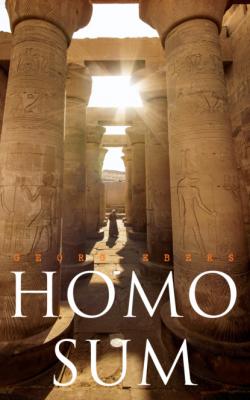Homo Sum. Georg Ebers
Читать онлайн.| Название | Homo Sum |
|---|---|
| Автор произведения | Georg Ebers |
| Жанр | Языкознание |
| Серия | |
| Издательство | Языкознание |
| Год выпуска | 0 |
| isbn | 4064066392444 |
Georg Ebers
Homo Sum
Historical Novel
Translator: Clara Bell
e-artnow, 2020
Contact: [email protected]
EAN: 4064066392444
Table of Contents
PREFACE.
In the course of my labors preparatory to writing a history of the Sinaitic peninsula, the study of the first centuries of Christianity for a long time claimed my attention; and in the mass of martyrology, of ascetic writings, and of histories of saints and monks, which it was necessary to work through and sift for my strictly limited object, I came upon a narrative (in Cotelerius Ecclesiae Grecae Monumenta) which seemed to me peculiar and touching notwithstanding its improbability. Sinai and the oasis of Pharan which lies at its foot were the scene of action.
When, in my journey through Arabia Petraea, I saw the caves of the anchorites of Sinai with my own eyes and trod their soil with my own feet, that story recurred to my mind and did not cease to haunt me while I travelled on farther in the desert.
A soul’s problem of the most exceptional type seemed to me to be offered by the simple course of this little history.
An anchorite, falsely accused instead of another, takes his punishment of expulsion on himself without exculpating himself, and his innocence becomes known only through the confession of the real culprit.
There was a peculiar fascination in imagining what the emotions of a soul might be which could lead to such apathy, to such an annihilation of all sensibility; and while the very deeds and thoughts of the strange cave-dweller grew more and more vivid in my mind the figure of Paulus took form, as it were as an example, and soon a crowd of ideas gathered round it, growing at last to a distinct entity, which excited and urged me on till I ventured to give it artistic expression in the form of a narrative. I was prompted to elaborate this subject—which had long been shaping itself to perfect conception in my mind as ripe material for a romance—by my readings in Coptic monkish annals, to which I was led by Abel’s Coptic studies; and I afterwards received a further stimulus from the small but weighty essay by H. Weingarten on the origin of monasticism, in which I still study the early centuries of Christianity, especially in Egypt.
This is not the place in which to indicate the points on which I feel myself obliged to differ from Weingarten. My acute fellow-laborer at Breslau clears away much which does not deserve to remain, but in many parts of his book he seems to me to sweep with too hard a broom.
Easy as it would have been to lay the date of my story in the beginning of the fortieth year of the fourth century instead of the thirtieth, I have forborne from doing so because I feel able to prove with certainty that at the time which I have chosen there were not only heathen recluses in the temples of Serapis but also Christian anchorites; I fully agree with him that the beginnings of organized Christian monasticism can in no case be dated earlier than the year 350.
The Paulus of my story must not be confounded with the “first hermit,” Paulus of Thebes, whom Weingarten has with good reason struck out of the category of historical personages. He, with all the figures in this narrative is a purely fictitious person, the vehicle for an idea, neither more nor less. I selected no particular model for my hero, and I claim for him no attribute but that of his having been possible at the period; least of all did I think of Saint Anthony, who is now deprived even of his distinguished biographer Athanasius, and who is represented as a man of very sound judgment but of so scant an education that he was master only of Egyptian.
The dogmatic controversies which were already kindled at the time of my story I have, on careful consideration, avoided mentioning. The dwellers on Sinai and in the oasis took an eager part in them at a later date.
That Mount Sinai to which I desire to transport the reader must not be confounded with the mountain which lies at a long day’s journey to the south of it. It is this that has borne the name, at any rate since the time of Justinian; the celebrated convent of the Transfiguration lies at its foot, and it has been commonly accepted as the Sinai of Scripture. In the description of my journey through Arabia Petraea I have endeavored to bring fresh proof of the view, first introduced by Lepsius, that the giant-mountain, now called Serbal, must be regarded as the mount on which the law was given—and was indeed so regarded before the time of Justinian—and not the Sinai of the monks.
As regards the stone house of the Senator Petrus, with its windows opening on the street—contrary to eastern custom—I may remark, in anticipation of well founded doubts, that to this day wonderfully well-preserved fire-proof walls stand in the oasis of Pharan, the remains of a pretty large number of similar buildings.
